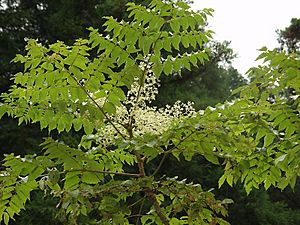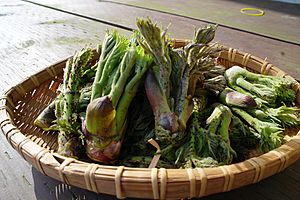Japanese angelica tree facts for kids
Quick facts for kids Japanese angelica tree |
|
|---|---|
 |
|
| Scientific classification | |
| Genus: |
Aralia
|
| Species: |
elata
|
The Aralia elata, also known as the Japanese angelica tree, Chinese angelica-tree, or Korean angelica-tree, is a type of woody plant. It belongs to the Araliaceae family. In Japan, it's called tara-no-ki (タラノキ; 楤木), and in Korea, it's known as dureup-namu (두릅나무).
Contents
Discover the Japanese Angelica Tree
This plant is a small tree or shrub that loses its leaves every year (it's deciduous). It can grow up to 10 meters (about 33 feet) tall. You can find it naturally in eastern Russia, China, Korea, and Japan.
What Does the Plant Look Like?
The tree has rough, gray bark with small prickles. Its leaves are very large, growing 60–120 cm (about 2-4 feet) long. They are double pinnate, which means they have many smaller leaflets arranged along a central stem.
In late summer, the plant produces many small, white flowers. These flowers grow in large clusters called umbels. After the flowers, small black drupes (like berries) appear.
The Japanese angelica tree is quite similar to an American plant called Aralia spinosa. Sometimes, people can confuse the two!
Growing the Japanese Angelica Tree
People often grow Aralia elata in gardens because of its interesting look. Sometimes, they choose types with different colored leaves (called variegated forms). This plant likes rich, deep soils and a bit of shade. However, it can also grow in poorer soils and in full sunlight.
Some special types of this plant, called 'Variegata' and 'Aureovariegata', have even won an award from the Royal Horticultural Society. This award is called the Award of Garden Merit.
Eating the Japanese Angelica Tree Shoots
The young shoots of the Japanese angelica tree are a popular food in some parts of Asia.
Japanese Tara-no-me Dishes
In Japan, the young shoots are called tara-no-me. People pick them from the ends of the branches in the spring. A very common way to eat them is to dip them in a light batter and then deep-fry them. This dish is called tempura.
Korean Dureup Delicacies
In Korea, the young shoot is known as dureup (두릅). The plant itself is called dureupnamu (두릅나무), which means "dureup tree." These tender shoots are gathered for about a month, usually from early April to early May, when they are soft and smell nice.
In Korean cuisine, dureup shoots are used in many ways. They are often:
- Blanched (briefly boiled) and served as a side dish called namul.
- Pickled to make jangajji.
- Pan-fried as a type of pancake called jeon.
- Deep-fried to make crispy snacks called bugak.
An Invasive Plant in Some Areas
The Japanese angelica tree was brought to the United States in 1830. Birds enjoy eating its fruits. When birds eat the fruits, they help spread the seeds to new places. Because of this, the tree has started to grow widely in the Northeastern United States, becoming an invasive species. This means it can sometimes take over areas where native plants used to grow.
Images for kids
-
Dureup-sukhoe (blanched angelica-tree shoot)
-
Dureup-bugak (angelica-tree shoot fritter) and chal-jeonbyeong (glutinous rice pancake)
-
Dureup-jeon (pan-fried angelica-tree shoot)








